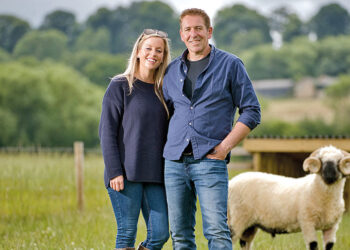Jenny Zarins/Ebury Press
Russell Norman’s version of the Tuscan bread soup is a powerful antidote to February
Here we sit, deep in the abyss of February, in need of soup mugs, DayQuil, hope, and nourishment. So thank goodness for recipes like Russell Norman’s spin on ribollita, the Tuscan bread soup whose comforting heft offers sustenance for both body and spirit. The recipe, which is built from a robust trinity of cannellini beans, kale, and stale bread, comes from Brutto: A (Simple) Florentine Cookbook. Published last October, it was Norman’s fourth cookbook, and, sadly, his last: in November, the restaurateur, chef, and author died unexpectedly at the age of 57.
Both Brutto and its ribollita recipe encapsulate the big-hearted flair that characterized Norman’s work. Norman broke onto London’s restaurant scene in 2009, when he and his then-business partner Richard Beatty opened Polpo, a Venetian-style spot whose casual, stripped-down atmosphere, no-reservations policy, and menu of small plates proved to be hugely influential among restaurants in London and abroad — Norman, once called “the coolest man in food,” is widely recognized as one of the progenitors of the small-plates trend, and Polpo’s great success led him and Beatty to open numerous restaurants together. Brutto, which Norman opened on his own in 2021, was inspired by Florentine trattorie; its name translates to “ugly” and is a nod to “brutto ma buono,” or ugly but beautiful, a term often used to describe fantastically good but unphotogenic food.
Like the restaurant, Brutto the cookbook is paradoxically full of beauty; it’s there in Jenny Zarins’s photographs of Florence and its cuisine, in the generosity of spirit that pervades the recipes, and in the love with which Norman writes about the city. It’s in the inherent promise of this ribollita, too: whether you make a pot to eat on your own or to serve as the centerpiece for a cozy dinner party, here is warmth that will sustain you for as long as the sun is away.
Cannellini Bean and Cavolo Nero Broth (Ribollita) Recipe
Serves 4
Ingredients:
300g dried cannellini beans
1 whole head of cavolo nero
Extra virgin olive oil
1 large onion, finely diced
1 large carrot, peeled and finely diced 1 celery stalk, finely diced
1 clove of garlic, finely chopped flaky sea salt
1 teaspoon fennel seeds, crushed a small handful of thyme leaves black pepper
1 tablespoon tomato purée
1 large potato, peeled and diced
300 milliliters vegetable stock
1 bay leaf
1⁄2 loaf of stale bread, crustless, torn into small chunks
Instructions:
Step 1: Soak the beans overnight in plenty of cold water in a very large bowl.
Step 2: The next day, when you’re ready to start cooking, drain the beans and transfer them to a large pan. Cover them well with fresh cold water, bring to the boil, then reduce to a low simmer for 1 hour until soft. Remove the scum while cooking as it comes to the surface. Retain a cup of the cooking water, drain the beans and set them aside.
Step 3: To prepare the head of cavolo nero, remove the base, then grab the thick ends of the stalks with one hand and gently pull the leaves away. Discard the stalks and base and roughly shred the leaves.
Step 4: In a large, heavy-based saucepan, heat a good glug or two of olive oil and gently sauté the onion, carrot, celery and garlic for a good 15 minutes, until soft and glossy. Add a pinch or two of salt, the crushed fennel seeds, the thyme and a twist of black pepper. Stir in the tomato purée.
Step 5: Now add the cooked beans, the diced potato, the stock and the bay leaf, and stir over a medium heat for about 45 minutes. Halfway through, add the chunks of stale bread and the shredded cavolo nero. Make sure the ingredients are submerged and always covered by liquid, stirring from time to time. Use the reserved bean cooking water if the broth is looking too dry.
Step 6: Remove the bay leaf and taste, adjusting the seasoning as required. Serve in four warmed bowls with a twist of black pepper and a drizzle of olive oil. Or leave it overnight and reheat the next day, staying true to the name of the dish.
Reprinted with permission from Brutto: A (Simple) Florentine Cookbook by Russell Norman published by Ebury Press, 2023. Photographs by Jenny Zarins, copyright © 2023.














